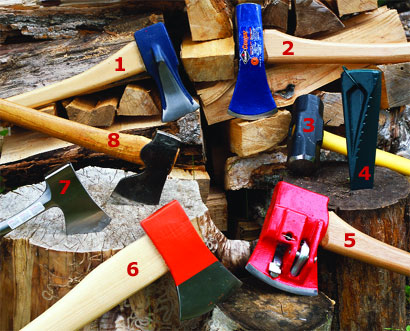Re-posted -
If all of your winter firewood has not been split yet, it is Splitting Maul Season.
Log splitting is a great joy, a great work-out, and useful. And it can be done as well by a 113-pound gal as by an 180-pound fellow because, when done properly, the maul does most of the work. Heck, it's a sort of lever. You lift it, then let gravity and leverage do the rest of the work, assuming you put the right English on the blow to your log. That is a matter of practice and experimentation, and a deep source of pleasure once this basic life skill is acquired.
Axes are terrible for wood-splitting. Wedges get stuck, cause huge frustration, and get lost in the field. There are all sorts of good mauls. This photo of mauls shows the spring-loaded maul, #5, which looks like a foolish gadget but which truly works well, and will really throw the wood around if you are wise and work on the edges and don't aim for the middle of a big one. Highly recommended by the Bird Dog Consumer Reports.

I approach a large log in the classic manner: I work around the edges, then I chop the corners off the remaining square, or pentagon, or whatever it might be. I like to end up with a square piece at the end. Knots? I never fight a knot just like I never argue with a Leftist/Statist. I burn them intact.
Very satisfying work and, as Thoreau said, it warms you twice: Once when you split it and again when you burn it. That is true Yankee economy.
Teach your children well...



One more load yesterday. This is well-seasoned White Ash, the tree from which baseball bats are made. I see some log-splitting in my future. Yes, that is a Fisher's Island sticker for those with sharp eyes. Very nice place, Fisher's - but no place for tou
Tracked: Oct 06, 17:20